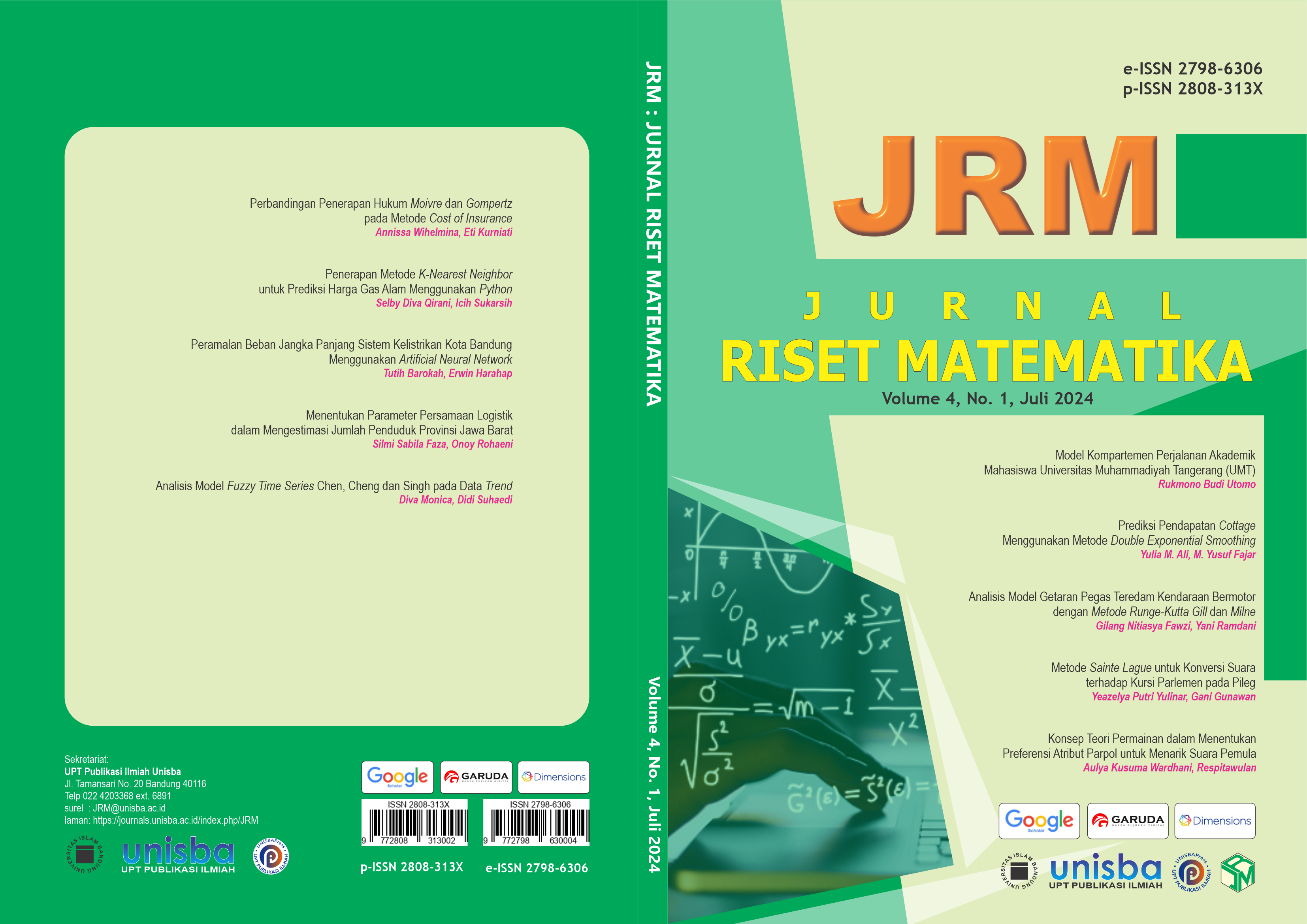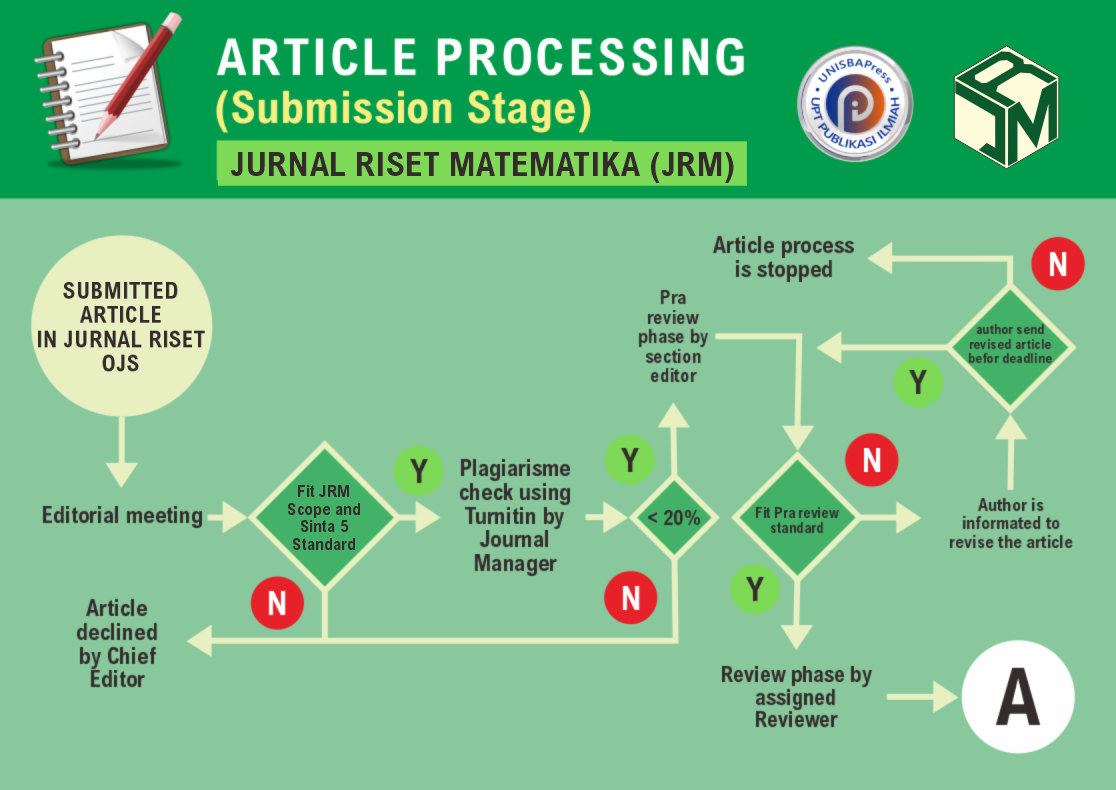Analisis Model Fuzzy Time Series Chen, Cheng dan Singh pada Data Trend
DOI:
https://doi.org/10.29313/jrm.v4i1.3605Keywords:
Data Trend, Fuzzy Time Series, Model ChenAbstract
Abstrak. Metode fuzzy time series adalah salah satu metode yang memanfaatkan kecerdasan buatan dengan kemampuan untuk bisa menangkap pola dari data yang telah ada sebelumnya. Kegiatan melakukan perbandingan pada model fuzzy time series sudah dilakukan oleh penelitian sebelumnya. Namun, pada penelitian sebelumnya hanya melakukan perbandingan model berdasarkan nilai akurasi prediksi pada data yang digunakan tanpa melihat perbedaan perhitungan dari masing-masing model. Untuk itu, penelitian ini mengkaji perbedaan model fuzzy time series Chen, Cheng, dan Singh, serta akurasinya pada peramalan data berpola trend. Model-model tersebut selanjutnya diaplikasikan untuk memprediksi data penumpang kereta api Jabodetabek periode Januari 2014 sampai Desember 2019. Hasil analisis model pada penelitian ini menunjukkan model Singh lebih baik dibandingkan model Chen. Model Cheng lebih baik dibandingkan model Chen. Hal tersebut sesuai dengan studi kasus pada data trend yang menghasilkan model Singh lebih akurat dibandingkan model Cheng dengan nilai MAPE model Singh sebesar 2,82%. Selanjutnya, model Cheng lebih baik dibandingkan dengan model Chen dengan nilai MAPE sebesar 5,7505% dan untuk nilai MAPE model Chen sebesar 7,2181%.
Abstract. The fuzzy time series method is one method that utilizes artificial intelligence with the ability to capture patterns from pre-existing data. Activities to compare fuzzy time series models have been carried out by previous research. However, previous studies only compared models based on the prediction accuracy value on the data used without seeing the difference in calculations from each model. For this reason, this study examines the differences in the Chen, Cheng, and Singh fuzzy time series models, as well as their accuracy in forecasting trend-patterned data. The models are then applied to predict Jabodetabek train passenger data for the period January 2014 to December 2019. The results of the model analysis in this study show that the Singh model is better than the Chen model. Cheng model is better than Chen model. This is in accordance with the case study on trend data which resulted in the Singh model being more accurate than the Cheng model with the Singh model MAPE value of 2,82%. Furthermore, the Cheng model is better than the Chen model with a MAPE value of 5,7505% and for the Chen model MAPE value of 7,2181%.
References
I. Admirani, “Penerapan Metode Fuzzy Time Series Untuk Prediksi Laba Pada Perusahaan,” Jurnal JUPITER, vol. 10, no. 1, pp. 19–31, 2018.
O. Kelana, A. Putra, N. Amalita, and A. Salma, “Comparison of the Chen and Singh’s Fuzzy Time Series Methods in Forecasting Farmer Exchange Rates in Indonesia,” UNP Journal of Statistics and Data Science, vol. 1, no. 4, pp. 264–270, 2023.
A. Febriyanti, “Penerapan Metode Fuzzy Time Series Chen dan Cheng Dalam Peramalan Rata-Rata Harga Beras Ditingkat Perdagangan Besar (Grosir) di Indonesia,” 2020.
F. Setiani, “Pengaplikasian Fuzzy Time Series Chen dan Fuzzy Time Series Cheng Dalam Memprediksi Kurs Rupiah Terhadap Dollar Singapura,” 2019.
H. Zamani, “Perbandingan Metode Fuzzy Time Series Model Chen dan Singh Pada Nilai Ekspor Indonesia Tahun 1999-2020,” 2020.
E. Heriansyah and S. Hasibuan, “Implementasi Metode Peramalan Pada Permintaan Bracket Side Stand K59A,” Jurnal PASTI, vol. 12, no. 2, pp. 209–223, 2018.
K. Nugroho, “Model Analisis Prediksi Menggunakan Metode Fuzzy Time Series,” INFOKAM, vol. 12, no. 1, pp. 46–50, 2016.
A. Khofi, D. Arifianto, and I. Saifudin, “Perbandingan Model Chen dan Model Lee pada Metode Fuzzy Time Series untuk Peramalan Harga Beras,” 2022.
R. Bakri, S. Inayati, Y. Yuliana, and A. Hanafiah, “Prediksi Jumlah Peserta BPJS Penerima Bantuan Iuran (PBI) APBN Menggunakan Metode Fuzzy Time Series Cheng,” BAREKENG: Jurnal Ilmu Matematika dan Terapan, vol. 15, no. 2, pp. 373–384, 2021.
M. Putri, “Peramalan Pertumbuhan Luas Areal Perkebunan Rakyat Kopi di Indonesia Pada Masa Mendatan Menggunakan Fuzzy Time Series Singh,” 2023.
S. M. Chen, “Forecasting enrollments based on Fuzzy Time Series,” Jun. 1996.
C. H. Cheng, T. L. Chen, H. J. Teoh, and C. H. Chiang, “Fuzzy time-series based on adaptive expectation model for TAIEX forecasting,” Expert Syst Appl, vol. 34, no. 2, pp. 1126–1132, Feb. 2008, doi: 10.1016/j.eswa.2006.12.021.
S. R. Singh, “A simple time variant method for Fuzzy Time Series forecasting,” Cybern Syst, vol. 38, no. 3, pp. 305–321, Mar. 2007, doi: 10.1080/01969720601187354.













